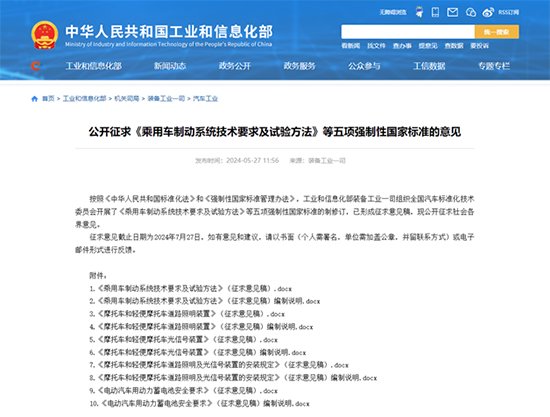Recently, the Ministry of Industry and Information Technology publicly solicited opinions on five mandatory national standards, including the “Technical Requirements and Test Methods for Passenger Car Brake Systems,” which involve changes in the application conditions of energy recovery braking functions for new energy vehicles, targeting the “single pedal mode.” This topic has sparked heated discussions on whether the “single pedal mode” should be banned. What is the single pedal mode?
The so-called “one-pedal mode” can be traced back to F1 racing cars. In 2007, engineers from two Renault F1 teams developed an efficient flywheel kinetic energy recovery system to store braking energy in the car and release it as auxiliary power during acceleration. Originally, the automotive industry did not have a definition for “one-pedal mode.” Now, it is commonly referred to as accelerating and decelerating by using the accelerator pedal, with the ability to come to a complete stop by releasing the accelerator pedal. This operation aims to achieve better energy recovery and increase the vehicle’s range. Vehicles with “one-pedal mode” still have both brake and accelerator pedals. Although Tesla is often associated with “one-pedal mode,” BMW was actually the first to implement this feature. The first generation BMW i3 released in 2013 used “one-pedal mode,” but it could not be turned off at that time. Why does “one-pedal mode” frequently lead to accidents? Despite its advantages in increasing vehicle range and extending brake pad life, “one-pedal mode” also poses safety risks. The change in operation from traditional driving habits can lead to misoperation and frequent traffic accidents.
Safety hazard 1: Breaking the habit of “pre-braking” during driving, most drivers habitually rest their foot on the brake pedal, known as “pre-braking,” to quickly brake in emergencies. However, the “single pedal mode” requires the foot to be on the accelerator pedal at all times. This delays reaction time as the foot needs to be moved to the brake pedal for braking, potentially causing accidents. Safety hazard 2: Weakening muscle memory for the brake pedal. Most drivers subconsciously press the brake pedal when needing to brake, forming muscle memory. However, with the “single pedal mode,” where both acceleration and deceleration are done through the accelerator pedal, sensitivity to the brake pedal is reduced. This can lead to mistaken use of the accelerator pedal as the brake pedal in high-stress situations. Media reports show that drivers new to the single pedal mode have a nearly 30% higher chance of making mistakes in emergencies compared to the traditional two-pedal mode. An example is the recent Tesla “roof rights case.” Ms. Zhang’s father drove a white Tesla sedan with four people on board in 2021, claiming that the Tesla’s “brake failure” caused it to not slow down at a red light intersection, resulting in rear-ending two cars and finally hitting a cement guardrail on the roadside before stopping. Ms. Zhang, not agreeing with Tesla’s investigation conclusion of “no abnormality in the vehicle’s braking system,” climbed onto the roof of a Tesla display car during the Shanghai Auto Show that year to seek justice, attracting widespread attention. However, in a recent first-instance judgment, the court found that Ms. Zhang had infringed Tesla’s reputation and should apologize and compensate Tesla for 172,275 yuan (23740$). Since the accident vehicle did not have a “brake failure,” it is highly likely that there was a “pedal misapplication.” In early June, there was an incident circulating online about “Xiaomi SU7 crashing out of a parking lot, resulting in one death and three injuries.” After Xiaomi’s investigation, it was found that “at the time of the accident, the brake pedal was in normal condition, while the accelerator pedal was continuously depressed.” It is worth noting that the Xiaomi SU7 also comes with a “single pedal mode.” Safety hazard three: inability to accurately control the vehicle’s speed. In regular driving, accelerating with the accelerator pedal and decelerating with the brake pedal, the two working together can more accurately control the vehicle’s speed. However, for the “single pedal mode,” using only one accelerator pedal to control both acceleration and deceleration makes it difficult to find the critical point between the two. Therefore, the control of driving speed is not as precise, and a slight mistake could potentially lead to a traffic accident. When it comes to driving safety, the “single pedal mode” should be “prohibited” rather than “selected.”
The Ministry of Industry and Information Technology publicly solicited opinions on the “Technical Requirements and Test Methods for Passenger Car Braking Systems.” The purpose is to reduce safety risks caused by driver errors and system failures. This is not the first time that policy has been revised regarding the “single pedal mode.” In May 2023, the State Administration for Market Regulation issued a recall notice, identifying Tesla’s “mandatory use of single pedal mode” as a product defect and ordering a recall. The current draft for public opinion can be seen as a policy upgrade for the “single pedal mode.” Specifically, for vehicles with Type A or both Type A and Type B regenerative braking systems, braking by releasing the accelerator pedal in forward gear should not bring the vehicle to a stop. Type A refers to vehicles without a driving brake system and energy recovery function, while Type B refers to vehicles with a driving brake system and energy recovery. The new provision from the Ministry of Industry and Information Technology prohibits the function of bringing the vehicle to a complete stop with the energy recovery function, without affecting the energy recovery function itself. Currently, there are three main opinions on the draft for public opinion. In addition to support and opposition, there are also calls not to be too rigid and to leave the choice to the users. While the third opinion seems fair, it overlooks the bottom line of driving safety. Friends who have learned to drive at a driving school know that there is no specialized training for the “single pedal mode.” They learn the traditional operation of “pressing the brake pedal for braking and pressing the accelerator for acceleration.” The subconscious reflex formed is to accelerate by pressing the accelerator and brake by pressing the brake pedal, with each having its own function. For the “single pedal mode”, whether experienced drivers or beginners, it is not possible to practice in a safe environment, only on public roads; there is a risk of confusing the accelerator pedal with the brake pedal, which is a huge safety hazard. Experts have said that as long as the accelerator pedal can also “brake”, the risk of mistakenly stepping on the accelerator as a brake cannot be eliminated. Therefore, letting consumers choose for themselves is obviously a temporary solution. For this function with obvious safety hazards, a uniform decision is the best choice. The root cause of the hazard must be eliminated, as it involves the safety of consumers’ lives and property, and cannot be taken lightly. The single pedal mode is not equivalent to kinetic energy recovery. Some friends may have doubts about canceling the “single pedal mode”: will it affect kinetic energy recovery? In fact, the “single pedal mode” and kinetic energy recovery are two different technologies, they cannot be equated. Tongji University’s Institute of Automotive Safety Technology director Zhu Xi Chan previously said in an interview that “energy recovery is not only done in single pedal mode, some electric friction will also be recovered when using the brakes.” Currently, mainstream car companies are actually using CRBS to achieve kinetic energy recovery, where the braking force of the brake pedal and the brake caliper is decoupled through line control, meaning their operations are not synchronous. The working principle of CRBS is simple: when you press the brake pedal, the control unit first slows down the electric motor in a way that recovers energy, and when the brake pedal pressure reaches a certain threshold, the traditional brake system completes the braking. Of course, the threshold set by each car company is different, so the amount of energy recovery achieved in the end also varies. In conclusion, from the actions of the Ministry of Industry and Information Technology this time, it can be seen that regulatory authorities are determined to ensure the safety of new energy vehicles. The public opinion storm triggered by this may drive the new energy vehicle industry towards a more mature and safer direction. It is undeniable that technological innovation is the core element for developing new productive forces, but it must be based on the foundation of “safety”.


